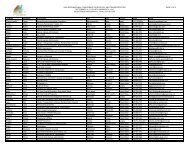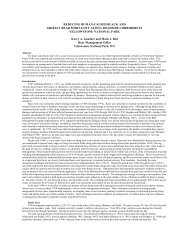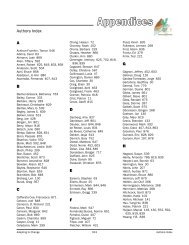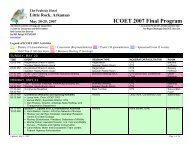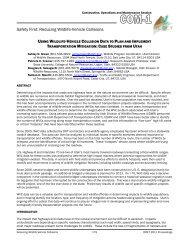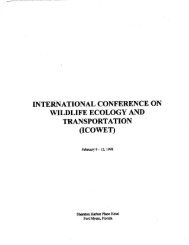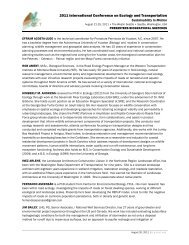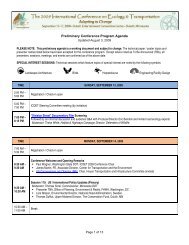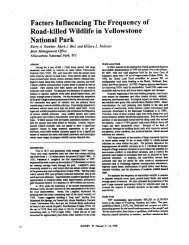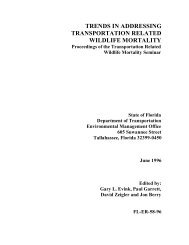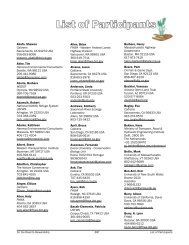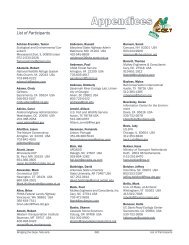Poster Sessions, pages 567-640 - ICOET
Poster Sessions, pages 567-640 - ICOET
Poster Sessions, pages 567-640 - ICOET
Create successful ePaper yourself
Turn your PDF publications into a flip-book with our unique Google optimized e-Paper software.
Environmental Scoping Application<br />
Early in the project development process, the ODOT Regional Environmental Coordinator (REC) visits a proposed project<br />
site to identify the environmental issues likely to be associated with the proposed project. This initial site reconnaissance<br />
serves to provide a coarse-level assessment of the expected environmental permitting requirements for the<br />
project. The REC typically populates a standard ODOT form designed to capture this information, and then produces<br />
a report based on the data collected during the site visit. This coarse-level assessment requires the REC to access<br />
numerous (>20) sources of environmental information (i.e. Oregon Natural Heritage Information, Hazardous Materials<br />
Sites, etc.) from the Web and from ODOT’s server prior to conducting the site reconnaissance.<br />
ODOT recognized that having the data from these databases available to the REC during the site reconnaissance would<br />
greatly increase efficiency and effectiveness. A further advantage of having the data available in the field is that the<br />
REC can record inaccuracies or omissions in the database information detected during the routine visit, thereby improving<br />
the quality of the base data. ODOT asked MB&G to design a handheld application, the Environmental Scoping<br />
Application, to meet this need. The key functionality desired by ODOT was the delivery of key environmental base data<br />
layers, ability to populate standard site reconnaissance field forms, and the ability to capture and edit spatially-referenced<br />
(via GPS) data while in the field.<br />
MB&G delivered Version 1 of the Environmental Scoping Application to ODOT in December 2005. Version 1 displays 21<br />
distinct data layers of environmental information for access by the REC during the site reconnaissance. In addition, this<br />
application allows the user to populate standard site reconnaissance field forms and to capture new point, line, and<br />
polygon data that are geo-referenced and associated with attribute forms. This Environmental Scoping Application has<br />
yet to be systematically field tested by ODOT, but this may occur in 2007.<br />
Conclusions<br />
SRSAM has increased ODOT’s efficiency with respect to environmental regulatory compliance and managing environmental<br />
resources by delivering sensitive natural resource data to personnel tasked with making decisions that<br />
could impact those resources: maintenance crews, biologists, and transportation planners. In addition, the handheld<br />
computer applications, as well as the SRSAM GIS, offer a solution to a difficult ODOT challenge by standardizing data<br />
collection and storage techniques throughout the state, thereby streamlining ODOT’s efforts to protect and manage<br />
sensitive resources.<br />
In summary, SRSAM has provided ODOT with the ability to deliver critical natural resource data to maintenance crews,<br />
biologists, and transportation planners making field decisions that could impact sensitive resources. The hand-held<br />
applications developed by ODOT and MB&G have enhanced and improved this ability, thus furthering the Agency’s<br />
resource protection and stewardship goals.<br />
Biographical Sketches: Bob Carson is a Principal with Mason, Bruce & Girard, Inc., and the manager of the Environmental Services Group.<br />
His 25 years of experience includes serving as environmental project manager or task leader on over 200 projects involving Endangered<br />
Species Act (ESA) and National Environmental Policy Act (NEPA) compliance and permitting, biological resource studies, and wetland<br />
delineation and mitigation. His technical expertise includes wildlife, forest, and wetland ecology and management. Bob is a Certified<br />
Wildlife Biologist and a certified Professional Wetland Scientist. He earned his Masters of Science in Wildlife Resources in 1984 from the<br />
University of Idaho, and Bachelor of Science in Forest Science in 1981 from The Pennsylvania State University.<br />
Milt Hill is an Environmental GIS Program Manager with the Oregon Department of Transportation (ODOT). His 19 years of experience with<br />
Geographic Information Systems (GIS) in State Government encompass a broad range of activities including computer system administration,<br />
GIS analysis, GIS project management, program administration, and contract and consultant management. Prior to his employment<br />
with ODOT, Milt was the GIS Program Coordinator for the Oregon Department of Fish and Wildlife (ODFW). Milt is a certified GIS<br />
Professional (GISP) and has completed the Oregon Project Management Certification Program (OPMCP). He earned his Bachelor of Science<br />
in Geography from Portland State University in 1989.<br />
Wendy Wente is an ecologist and project manager with Mason, Bruce & Girard, Inc. She has 13 years of experience in research design and<br />
implementation. Her professional expertise includes wildlife surveys, habitat assessments and field research designed to meet the needs<br />
of public sector clients. She specializes in federal permitting documentation primarily associated with the Endangered Species Act and the<br />
National Environmental Policy Act. Wendy earned a Bachelor of Science degree in Zoology in 1992 from Miami University in Oxford, Ohio.<br />
She completed her Ph.D. in Ecology, Evolution, and Animal Behavior at Indiana University in 2001. Prior to joining MB&G, Wendy worked<br />
as a post-doctoral researcher with the US Geological Survey, where she conducted research on problems of applied ecology including a<br />
multi-year study of regional amphibian decline and an experimental study of the effects of cattle grazing on wetland water quality.<br />
References<br />
Carson, Robert, Robert Kirkman, and Jason Neil. 2001. ODOT’s Salmon Resource and Sensitive Area Mapping Project: a high-tech<br />
procedure for obtaining biological resource data for resource protection and regulatory compliance. Pages 149-154 in Proceedings of<br />
the International Conference on Ecology and Transportation, September 24-28, Keystone, CO.<br />
Carson, Robert, Robert Kirkman, Rick Jones, and Jason Neil. 2003. ODOT’s Salmon Resource and Sensitive Area Mapping Project—application<br />
delivery of GIS biological resource data. Pages 548-551 in Proceedings of the International Conference on Ecology and<br />
Transportation, August 24-29, Lake Placid, NY.<br />
Mason, Bruce & Girard, Inc. 2006. Combined 2nd And 3rd Year Compensatory Wetland Mitigation Monitoring Report (2005/2006). U.S.<br />
26: Zigzag-Rhododendron Section, U.S. 26, Mt. Hood Highway. ODOT Key No. 07990. Clackamas County, Oregon<br />
Bridging the Gaps, Naturally 589 <strong>Poster</strong>s



